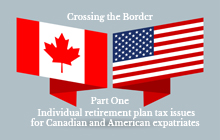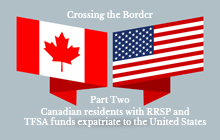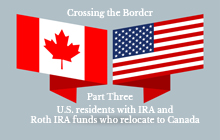Crossing the border, part two: Individual retirement plan tax issues for Canadian and American expatriates

In the second part of a three-part series on cross-border tax issues, Professor George Gonzalez looks at Canadian residents with RRSP and TFSA funds who expatriate to the United States
 |
George Gonzalez, PhD is Associate Professor at the Calgary campus of the University of Lethbridge. He is a Chartered Professional Accountant (CPA, CA, Ontario) and a Certified Public Accountant (CPA, Florida). |
THIS is the second in a three-part series on Canadian and U.S. cross-border tax issues related to individual employee retirement plans. The first article provided general information about individual employee retirement plans, based on a framework of a retirement plan’s three main phases. In this article we review the first of two general scenarios, in which a Canadian resident with RRSP and TFSA funds expatriates to the United States. In the third article the reverse situation is addressed: when an individual with U.S. IRA and Roth IRA funds relocates to Canada.
II. Situation #1: A Canadian Resident with RRSP and TFSA Funds Expatriates to the U.S.
Topics covered in this section:
A. Canadian Departure Tax
B.1. Canadian Taxation of a U.S. Resident’s RRSP
B.2. Canadian Taxation of a U.S. Resident’s TFSA
C.1. U.S. Taxation of a U.S. Resident’s RRSP
C.2. U.S. Taxation of a U.S. Resident’s TFSA
D. Transfer of Funds from a RRSP to an IRA or from a TFSA to a Roth IRA
E. Canadian Information Reporting for RRSPs and TFSAs
F. U.S. Information Reporting for RRSPs and TFSAs
II.A. Canadian Departure Tax: Under the departure tax rules of paragraph 128.1(4)(b) of the ITA[1], a Canadian resident who emigrates to another country is deemed to have disposed of certain types of property at their fair market value on the last day of residency. RRSPs and TFSAs are both specifically excluded from these deemed disposition rules, however. As such, they are not taxed under Canadian departure tax rules.
II.B.1. Canadian Taxation of a U.S. Resident’s RRSP
Contribution Phase – RRSP: Post-emigration, a Canadian non-resident who has RRSP contribution room is allowed to make additional contributions to their RRSP, up to the limit of that room. A deduction for such a contribution is allowable to the extent that the non-resident has Canadian-source income reported in a non-resident tax return filed with the CRA[2][3]. Additional RRSP contribution room cannot be created after emigration unless the non-resident earns Canadian source employment income.
Accumulation Phase - RRSP: The same taxation rules applicable to Canadian residents apply to non-residents: income earned within a RRSP account is not taxable.
Distribution Phase – RRSP: A distribution from a RRSP is Canadian source income that is subject to Canadian taxation. While a resident’s RRSP withdrawal is taxed under Part I of the ITA, a non-resident’s RRSP withdrawal is, by default, taxed under Part III in the form of a non-resident withholding tax that the payor withholds at the source and remits to the CRA[4]. Under the Canada-U.S. tax treaty (“the Treaty”), the withholding tax rate on a RRSP distribution that qualifies as a periodic payment[5] is 15%; otherwise, the withholding tax rate is 25%. Payment of the withholding tax is considered the final tax obligation; in other words, a tax return is not required for Part III income on which the non-resident withholding tax has been paid[6].
II.B.2. Canadian Taxation of a U.S. Resident’s TFSA
Contribution Phase – TFSA: With a TFSA, no contributions to the account are allowed for non-residents, irrespective of whether the individual earns Canadian-source employment income after expatriating.
Accumulation Phase - TFSA: The same taxation rules applicable to Canadian residents apply to non-residents: income earned within a TFSA is not taxable.
Distribution Phase – TFSA: The same taxation rules applicable to Canadian residents apply to non-residents: distributions from a TFSA are tax-free.
II.C.1. U.S. Taxation of a U.S. Resident’s RRSP
Contribution Phase – RRSP: Post-emigration, a Canadian non-resident who has RRSP contribution room is allowed to make additional contributions to their RRSP, up to the limit of that room. If the non-resident makes a contribution to their RRSP, under the Treaty the contribution is deductible for U.S. tax purposes if, and only if, it would otherwise be deductible as a contribution to an IRA. Essentially this means that the individual would have to receive employment income during the year and meet other IRA deductibility requirements based on their filing status, income for the year, whether they were covered under an employer-sponsored plan, etc.
Accumulation Phase - RRSP: The Treaty places RRSPs on the same footing as IRAs, such that accumulations within an RRSP are not taxable in the U.S.
Distribution Phase – RRSP: The Treaty places RRSPs on the same footing as IRAs, such that distributions from an RRSP are fully taxable in the U.S., just as IRA distributions would be.
II.C.2. U.S. Taxation of a U.S. Resident’s TFSA
Contribution Phase – TFSA: There are no provisions within the Treaty regarding TFSAs. Contributions to a TFSA are not allowed for Canadian non-residents under Canadian tax law, but regardless there would be no effect on U.S. taxes of such a contribution.
Accumulation Phase - TFSA: There are no provisions within the Treaty regarding TFSAs. The U.S. regards a TFSA like any other investment account. Accordingly, income accumulations within a TFSA are subject to U.S. taxation.
It is worth noting, however, that the tax resulting from the inclusion of TFSA income in a U.S. tax return could potentially be mitigated if there is Canadian tax paid on Canadian passive income from non-TFSA sources. In this regard it would be necessary to perform tax calculations to determine if there is a net U.S. tax effect on TFSA income accumulations.
Distribution Phase – TFSA: Since, as previously noted, the U.S. regards a TFSA like any other investment account, a distribution from a TFSA carries no special tax treatment (unless, for example, the distribution itself triggers a capital gain or some other resulting income).
II.D. Transfer of Funds from a RRSP to an IRA or from a TFSA to a Roth IRA
RRSP to a U.S. IRA: A transfer of funds from a RRSP to an IRA is not permitted. As explained in the next article in the series, however, a transfer in the reverse direction (from an IRA to a RRSP) is permitted.
TFSA to a U.S. Roth IRA: A transfer of funds from a TFSA to a Roth IRA is not permitted. Nor, as explained in the next article in this series, is a transfer from a Roth IRA to a TFSA permitted.
II.E. Canadian Information Reporting for RRSPs and TFSAs
Neither a resident nor a non-resident of Canada has information reporting obligations related to the holding of RRSPs or TFSAs.
II.F. U.S. Information Reporting for RRSPs and TFSAs
II.F.1. U.S. Reporting Requirements – RRSPs: There are two main information reporting forms that U.S. residents and U.S. citizens may be required to file if they have funds in a RRSP: the Foreign Bank and Financial Account Report (FinCEN Form 114) and the Statement of Specified Foreign Financial Assets (IRS[7] Form 8938).
The Foreign Bank and Financial Account Report (FinCEN Form 114), commonly known as the FBAR, is an annual report that is required if the total of the taxpayer’s foreign accounts owned and for which the taxpayer has signing authority exceed US$10,000 during the year. It is filed with the Treasury Department (the IRS’s boss, in a similar way to how the Finance Department is the CRA’S boss). A RRSP is considered a foreign account for purposes of the FBAR and is thus includable in the annual FBAR.
The Statement of Specified Foreign Financial Assets (IRS Form 8938) is an annual reporting form that may be required of a Canadian who resides in the U.S. It is filed with the IRS[8] if the total of the taxpayer’s foreign financial assets exceeds the applicable threshold. A RRSP falls under the definition of a foreign financial asset for purposes of Form 8938. The reporting threshold is based on the taxpayer’s residency and U.S. filing status:
- For a resident individual who is unmarried or married and filing separately, Form 8938 is required if the total of their specified foreign financial assets is more than $50,000 on the last day of the tax year or more than $75,000 at any time during the tax year.
- For a resident who is married and files jointly, the Form 8938 thresholds are doubled to $100,000 and $150,000, respectively.
- S. citizens who are non-residents have higher reporting threshold, not applicable for this discussion.
Depending on the makeup of one’s financial accounts, it is possible to have a filing requirement for only the FBAR, or for only Form 8938, or for both.
Annual Return to Report Transactions With Foreign Trusts and Receipt of Certain Foreign Gifts (IRS Form 3520): Noteworthy about this form is that the Internal Revenue Service (IRS) has specifically exempted RRSPs from its reporting requirements (a RRSP as a foreign trust would otherwise be subjected to Form 3520 requirements). Similarly, for RRSPs there is no requirement to file the related Annual Information Return of Foreign Trust with a US Owner (Form 3520-A).
II.F.2. U.S. Reporting Requirements – TFSAs: Unlike with RRSPs, the IRS has not issued any guidance on information reporting requirements for TFSAs. Tax advisers differ on whether a TFSA should be reported in a FBAR, or Form 8938, or Form 3520, or Form 3520-A, or not at all. My own recommendation for Canadians residing in the U.S. is to report their TFSA in Forms 3520 and 3520-A (referred to above). My reasoning is that the reporting requirements for Forms 3520 and 3520-A are more comprehensive than for the FBAR or Form 8938, and therefore this approach would be the most conservative and most likely to avoid potential non-compliance penalties.
In this article we examined the scenario in which a Canadian resident with RRSP and TFSA funds moves to the U.S. In the third, and final, article of this series we will look at the reverse situation, in which an individual with U.S. IRA and Roth IRA funds relocates to Canada.
FOOTNOTES
[1] ITA = Income Tax Act (ITA)
[2] CRA = Canada Revenue Agency
[3] If all of a non-resident’s Canadian income tax for a year is paid through non-resident withholding taxes (under Part III of the ITA), no RRSP deduction is allowable. However, if the taxpayer elects to file an optional Section 217 tax return for pension income, which includes RRSP withdrawals, in lieu of paying tax on that income through withholding, a RRSP deduction may be allowable.
[4] A taxpayer may elect to pay tax on RRSP withdrawals and other pension income, in lieu of the Part III withholding tax, by making a Section 217 election and paying tax under Part I.
[5] The RRSP’s plan administrator has the discretion to determine if a distribution is a periodic payment or not.
[6] As stated in footnote 4, tax may be paid be electing to file a Section 217 tax return, instead of paying tax under Part III tax withholding.
[7] IRS = Internal Revenue Service
[8] Form 8938 is typically included with the filing of the U.S. Individual Income Tax Return (Form 1040)
George Gonzalez, PhD is Associate Professor at the Calgary campus of the University of Lethbridge. He is a Chartered Professional Accountant (CPA, CA, Ontario) and a Certified Public Accountant (CPA, Florida). Title image: iStock (modified). Author photo courtesy George Gonzalez. Read the entire three-part series:
Crossing the border, part one: Individual retirement plan tax issues for Canadian and American expatriates
Crossing the border, part two: Individual retirement plan tax issues for Canadian and American expatriates
Crossing the border, part three: Individual retirement plan tax issues for Canadian and American expatriates










(0) Comments